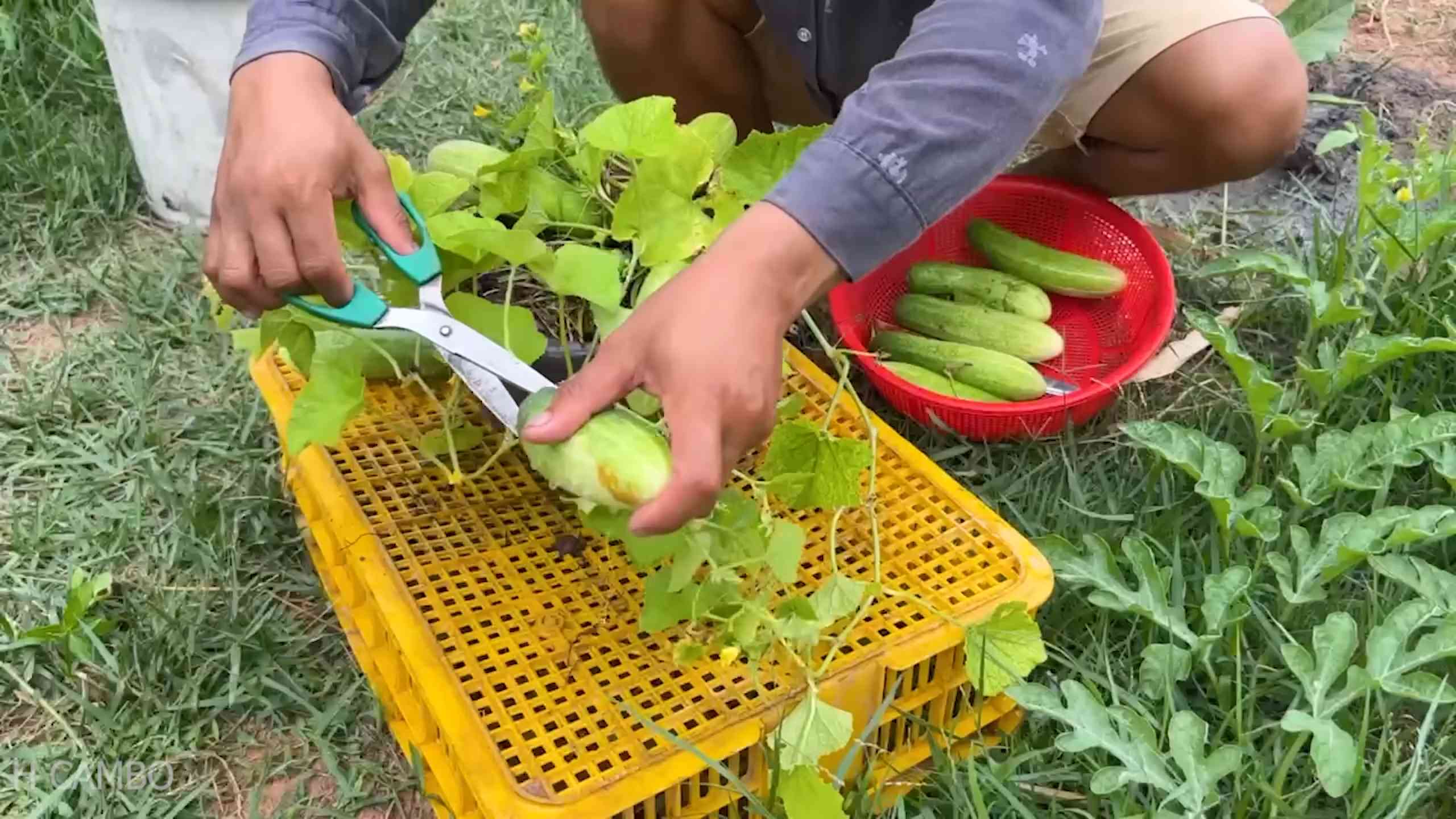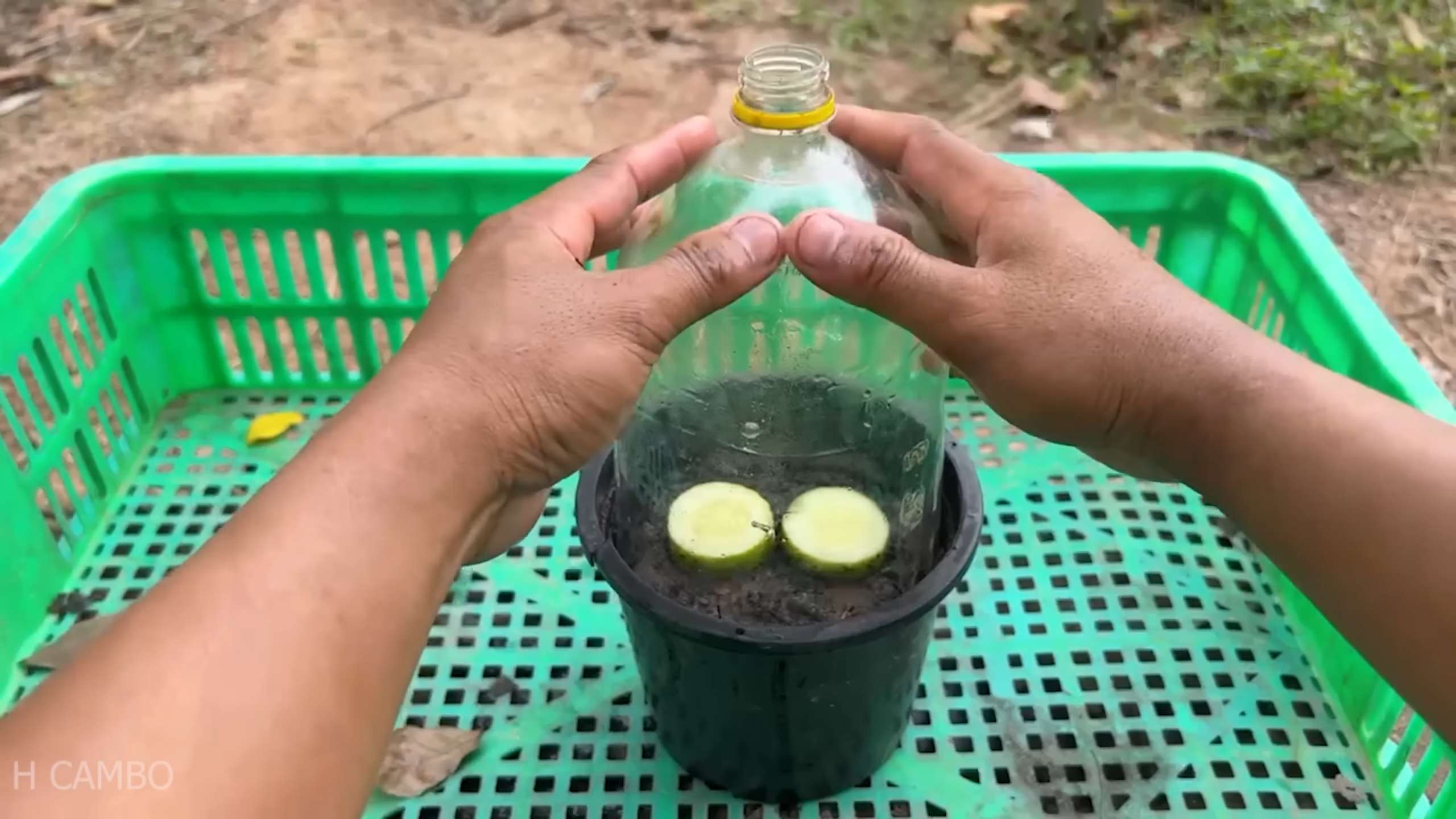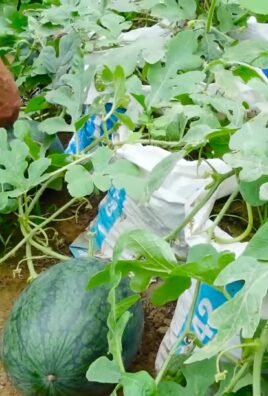Grow Cucumbers at Home – imagine plucking crisp, refreshing cucumbers straight from your own backyard! It’s not just a dream; it’s an achievable reality with a few clever tricks and a dash of DIY spirit. For centuries, cucumbers have been cultivated across various cultures, from ancient Rome where emperors demanded them year-round, to Asia where they’re symbols of good health and longevity.
But let’s be honest, sometimes growing these delightful veggies can feel like a battle against pests, diseases, and unpredictable weather. That’s where these DIY hacks come in! I’m going to share some simple, yet effective, techniques that will help you grow cucumbers at home like a pro, even if you’re a complete beginner.
Why do you need these tricks? Because store-bought cucumbers simply can’t compare to the taste and satisfaction of harvesting your own. Plus, you’ll know exactly what’s gone into growing them – no nasty chemicals or hidden surprises. Get ready to transform your garden into a cucumber paradise and enjoy a summer filled with delicious, homegrown goodness!

Growing Cucumbers at Home: A Beginner’s Guide
Hey there, fellow gardening enthusiasts! I’m so excited to share my tried-and-true method for growing delicious, crisp cucumbers right in your own backyard (or even on your balcony!). Trust me, there’s nothing quite like the satisfaction of biting into a cucumber you’ve nurtured from seed to harvest. Let’s dive in!
Choosing Your Cucumber Variety
Before we get our hands dirty, let’s talk about cucumber varieties. There are tons to choose from, and the best one for you will depend on your space, climate, and what you plan to do with your cucumbers.
* **Slicing Cucumbers:** These are your classic, long, smooth-skinned cucumbers perfect for salads and sandwiches. Think ‘Marketmore’ or ‘Straight Eight’.
* **Pickling Cucumbers:** Shorter and stubbier with bumpy skin, these are ideal for making pickles. ‘National Pickling’ and ‘Boston Pickling’ are popular choices.
* **Bush Cucumbers:** If you’re short on space, bush varieties like ‘Spacemaster’ or ‘Bush Champion’ are your best bet. They grow in a compact form, making them great for containers.
* **Gynoecious Hybrids:** These varieties produce mostly female flowers, which means more cucumbers! They often require a pollinator variety planted nearby.
I personally love growing ‘Marketmore’ for slicing and ‘National Pickling’ for, well, pickling!
Preparing for Planting
Okay, now that we’ve picked our cucumber champions, let’s get ready for planting. Cucumbers are warm-weather lovers, so timing is key.
* **Timing:** Wait until the danger of frost has passed and the soil has warmed up to at least 60°F (15°C). I usually aim for late spring or early summer.
* **Sunlight:** Cucumbers need at least 6-8 hours of sunlight per day. Choose a spot in your garden that gets plenty of sunshine.
* **Soil:** Cucumbers thrive in well-drained, fertile soil. Amend your soil with compost or well-rotted manure to improve drainage and add nutrients. A slightly acidic to neutral pH (6.0-7.0) is ideal.
* **Support:** Many cucumber varieties are vining and need support to climb. You can use a trellis, fence, or even a tomato cage. This helps keep the fruits off the ground, preventing rot and making harvesting easier. Bush varieties don’t need support.
Starting Seeds Indoors (Optional)
While you can direct sow cucumber seeds, starting them indoors gives them a head start, especially in cooler climates.
1. **Sow Seeds:** About 3-4 weeks before the last expected frost, sow cucumber seeds in peat pots or biodegradable containers filled with seed-starting mix. Plant the seeds about 1 inch deep.
2. **Provide Warmth and Light:** Keep the soil moist and warm (around 70-80°F or 21-27°C). Use a heat mat if needed. Provide plenty of light, either from a sunny window or a grow light.
3. **Harden Off Seedlings:** Before transplanting your seedlings outdoors, you need to “harden them off.” This means gradually exposing them to outdoor conditions over a week or two. Start by placing them outside for a few hours each day in a sheltered spot, gradually increasing the time and exposure to sunlight.
Planting Cucumbers
Whether you started seeds indoors or are direct sowing, the planting process is similar.
1. **Prepare the Planting Area:** Dig holes about 1 inch deep and space them according to the variety you’re growing. For vining varieties, space plants 12-18 inches apart along a trellis or fence. For bush varieties, space plants 2-3 feet apart.
2. **Plant the Seeds or Seedlings:** If direct sowing, plant 2-3 seeds per hole. If transplanting seedlings, gently remove them from their containers and place them in the holes.
3. **Cover and Water:** Cover the seeds or seedlings with soil and gently water them in.
4. **Mulch:** Apply a layer of mulch around the plants to help retain moisture, suppress weeds, and keep the soil cool. Straw, wood chips, or shredded leaves work well.
Caring for Your Cucumber Plants
Now comes the fun part – watching your cucumbers grow! Here’s what you need to do to keep them happy and healthy.
* **Watering:** Cucumbers need consistent moisture, especially during hot weather. Water deeply and regularly, aiming for about 1 inch of water per week. Avoid overhead watering, which can lead to fungal diseases. Drip irrigation or soaker hoses are ideal.
* **Fertilizing:** Feed your cucumber plants every 2-3 weeks with a balanced fertilizer. You can also use compost tea or fish emulsion.
* **Weeding:** Keep the area around your cucumber plants free of weeds. Weeds compete for nutrients and water.
* **Pruning (for vining varieties):** Pruning can help improve air circulation and encourage fruit production. Remove any yellowing or diseased leaves. You can also pinch off the tips of the vines to encourage branching.
* **Pollination:** Cucumbers need to be pollinated to produce fruit. If you’re growing them indoors or in an area with limited pollinators, you may need to hand-pollinate. Use a small paintbrush to transfer pollen from the male flowers (which have a long, thin stem) to the female flowers (which have a small cucumber behind the flower).
Dealing with Pests and Diseases
Unfortunately, cucumbers are susceptible to a few pests and diseases. Here’s how to deal with them:
* **Cucumber Beetles:** These little beetles can damage leaves and spread diseases. Handpick them off the plants or use row covers to protect your cucumbers.
* **Squash Bugs:** Similar to cucumber beetles, squash bugs can suck the sap from your plants. Handpick them off or use insecticidal soap.
* **Aphids:** These tiny insects can cluster on the undersides of leaves and suck the sap. Spray them off with a strong stream of water or use insecticidal soap.
* **Powdery Mildew:** This fungal disease causes a white, powdery coating on the leaves. Improve air circulation by pruning and avoid overhead watering. You can also use a fungicide if necessary.
* **Downy Mildew:** Another fungal disease that causes yellow spots on the leaves. Similar to powdery mildew, improve air circulation and avoid overhead watering. Use a fungicide if necessary.
I’ve found that regular inspection of my plants and early intervention are key to preventing major problems.
Harvesting Cucumbers
The moment we’ve all been waiting for – harvesting!
* **Timing:** Cucumbers are usually ready to harvest about 50-70 days after planting, depending on the variety. Harvest them when they are the desired size and color. Slicing cucumbers should be firm and dark green. Pickling cucumbers should be smaller and have a slightly bumpy skin.
* **How to Harvest:** Use a sharp knife or pruners to cut the cucumber from the vine, leaving a small stem attached.
* **Frequency:** Harvest cucumbers regularly to encourage continued production. Overripe cucumbers can become bitter and slow down the plant’s growth.
I usually check my cucumber plants every day during peak season to make sure I’m harvesting them at the perfect time.
Storing Cucumbers
Once you’ve harvested your bounty, you’ll want to store them properly.
* **Refrigeration:** Store cucumbers in the refrigerator for up to a week. Wrap them in plastic wrap or place them in a plastic bag to prevent them from drying out.
* **Pickling:** If you’ve grown pickling cucumbers, you can pickle them to preserve them for longer. There are tons of great pickling recipes online.
* **Freezing:** Cucumbers don’t freeze well on their own, as they become mushy when thawed. However, you can freeze them in pureed form for use in soups or smoothies.
Troubleshooting
Sometimes, things don’t go as planned. Here are a few common problems and how to fix them:
* **Yellowing Leaves:** This could be caused by overwatering, underwatering, nutrient deficiencies, or disease. Check the soil moisture and adjust your watering accordingly. Fertilize your plants and inspect them for signs of disease.
* **Blossom End Rot:** This is caused by a calcium deficiency and results in a dark, sunken spot on the blossom end of the cucumber. Ensure consistent watering and add calcium to the soil.
* **Bitter Cucumbers:** This can be caused by stress, such as inconsistent watering, high temperatures, or nutrient deficiencies. Provide consistent care and avoid stressing your plants.
Enjoying Your Homegrown Cucumbers
Now that you’ve successfully grown your own cucumbers, it’s time to enjoy them! Here are a few ideas:
* **Salads:** Add sliced cucumbers to your favorite salads.
* **Sandwiches:** Use cucumber slices as a refreshing addition to sandwiches.
* **Pickles:** Make your own homemade pickles.
*

Conclusion
So, there you have it! Growing cucumbers at home isn’t just a fun gardening project; it’s a gateway to enjoying the freshest, most flavorful cucumbers you’ve ever tasted. Forget those bland, waxed cucumbers from the grocery store. Imagine biting into a crisp, juicy cucumber, still warm from the sun, knowing you nurtured it from seed to harvest. That’s the magic of homegrown.
This DIY approach to growing cucumbers offers a level of control and satisfaction you simply can’t get any other way. You dictate the growing conditions, ensuring your plants receive the best possible care. You choose the varieties that appeal to your taste buds, from classic slicing cucumbers to pickling varieties perfect for homemade pickles. And you avoid the pesticides and preservatives often found in commercially grown produce.
But the benefits extend beyond just taste and control. Gardening is a fantastic stress reliever, a way to connect with nature, and a rewarding hobby that provides a tangible sense of accomplishment. Watching your cucumber plants thrive, producing an abundance of delicious fruit, is an incredibly gratifying experience.
Why is this DIY cucumber growing method a must-try? Because it empowers you to enjoy fresh, healthy, and delicious cucumbers on your own terms. It’s a sustainable way to source your produce, reducing your carbon footprint and supporting a healthier lifestyle. And it’s a fun and engaging activity that the whole family can enjoy.
Looking for variations? Consider these ideas:
* Vertical Gardening: If you’re short on space, train your cucumber vines to grow vertically on a trellis or fence. This not only saves space but also improves air circulation and reduces the risk of disease.
* Container Gardening: Cucumbers can thrive in containers, making them ideal for balconies, patios, or small gardens. Choose a large container (at least 5 gallons) and use a well-draining potting mix.
* Companion Planting: Plant cucumbers alongside beneficial companion plants like marigolds, nasturtiums, or basil to deter pests and attract pollinators.
* Different Varieties: Experiment with different cucumber varieties to find your favorites. Consider Armenian cucumbers, lemon cucumbers, or pickling cucumbers for a unique twist.
* Hydroponics: For the adventurous gardener, explore hydroponic cucumber growing for faster growth and higher yields.
Don’t be intimidated if you’re a beginner. Growing cucumbers at home is easier than you might think. With a little planning, preparation, and care, you can enjoy a bountiful harvest of delicious cucumbers all season long.
We encourage you to give this DIY cucumber growing method a try. Start small, learn as you go, and don’t be afraid to experiment. And most importantly, share your experiences with us! We’d love to hear about your successes, challenges, and favorite cucumber varieties. Post your photos, tips, and questions in the comments below. Let’s create a community of homegrown cucumber enthusiasts! Embrace the joy of growing cucumbers at home and savor the taste of fresh, homegrown goodness.
Frequently Asked Questions (FAQ)
What is the best time to start growing cucumbers?
The ideal time to start growing cucumbers depends on your climate. Cucumbers are warm-season vegetables and are sensitive to frost. In most regions, you can start seeds indoors 3-4 weeks before the last expected frost. Once the soil has warmed up to at least 60°F (15°C), you can transplant the seedlings outdoors. If you live in a warmer climate with a longer growing season, you can direct sow cucumber seeds directly into the garden after the last frost. Check your local weather forecast and planting guides for specific recommendations for your area.
How much sunlight do cucumbers need?
Cucumbers need at least 6-8 hours of direct sunlight per day to thrive. Choose a sunny location in your garden where your cucumber plants will receive ample sunlight throughout the day. If you’re growing cucumbers in containers, make sure to place them in a sunny spot on your patio or balcony. Insufficient sunlight can lead to stunted growth, reduced yields, and pale, flavorless cucumbers.
What kind of soil is best for growing cucumbers?
Cucumbers prefer well-draining, fertile soil that is rich in organic matter. Amend your garden soil with compost, aged manure, or other organic materials to improve its drainage, fertility, and water-holding capacity. The ideal soil pH for cucumbers is between 6.0 and 7.0. You can test your soil pH using a soil testing kit and adjust it accordingly with lime or sulfur.
How often should I water my cucumber plants?
Cucumbers need consistent moisture to produce healthy, juicy fruits. Water your cucumber plants deeply and regularly, especially during hot, dry weather. Aim to keep the soil consistently moist but not waterlogged. Water at the base of the plants to avoid wetting the foliage, which can increase the risk of fungal diseases. Mulching around your cucumber plants can help retain moisture in the soil and suppress weeds.
What are some common pests and diseases that affect cucumbers?
Cucumbers are susceptible to a variety of pests and diseases, including aphids, cucumber beetles, squash bugs, powdery mildew, and downy mildew. Regularly inspect your cucumber plants for signs of pests or diseases. If you spot any problems, take action promptly to prevent them from spreading. You can use organic pest control methods, such as insecticidal soap or neem oil, to control aphids and other pests. To prevent fungal diseases, ensure good air circulation around your plants, avoid overhead watering, and apply a fungicide if necessary.
How do I know when my cucumbers are ready to harvest?
Cucumbers are typically ready to harvest 50-70 days after planting, depending on the variety. The size and color of the cucumbers will vary depending on the variety, so check the seed packet or plant tag for specific harvesting instructions. Generally, cucumbers are ready to harvest when they are firm, smooth, and have reached the desired size. Avoid letting cucumbers become overripe, as they can become bitter and seedy. Harvest cucumbers regularly to encourage continued production.
Can I grow cucumbers in containers?
Yes, cucumbers can be successfully grown in containers, making them a great option for gardeners with limited space. Choose a large container (at least 5 gallons) with drainage holes. Use a well-draining potting mix and provide a trellis or other support for the vines to climb. Water and fertilize your container-grown cucumbers regularly, as they will dry out and deplete nutrients more quickly than cucumbers grown in the ground.
How can I prevent my cucumbers from becoming bitter?
Cucumber bitterness is often caused by stress, such as inconsistent watering, high temperatures, or nutrient deficiencies. To prevent bitterness, provide your cucumber plants with consistent moisture, adequate sunlight, and fertile soil. Choose cucumber varieties that are known to be less prone to bitterness. You can also try peeling the cucumbers before eating them, as the bitterness is often concentrated in the skin.
What are some good companion plants for cucumbers?
Companion planting can help improve the health and productivity of your cucumber plants. Some good companion plants for cucumbers include:
* Marigolds: Deter pests like nematodes and aphids.
* Nasturtiums: Attract beneficial insects and repel pests.
* Basil: Repels pests and improves the flavor of cucumbers.
* Beans: Fix nitrogen in the soil, benefiting cucumber growth.
* Radishes: Deter cucumber beetles.
Avoid planting cucumbers near aromatic herbs like sage, as they can inhibit cucumber growth.
How do I save cucumber seeds for next year?
To save cucumber seeds, allow a few cucumbers to fully ripen on the vine. They will turn yellow or orange and become very large. Scoop out the seeds and pulp and place them in a jar with water. Let the mixture ferment for a few days to remove the gelatinous coating from the seeds. Rinse the seeds thoroughly and spread them out on a paper towel to dry completely. Store the dried seeds in an airtight container in a cool, dry place.




Leave a Comment